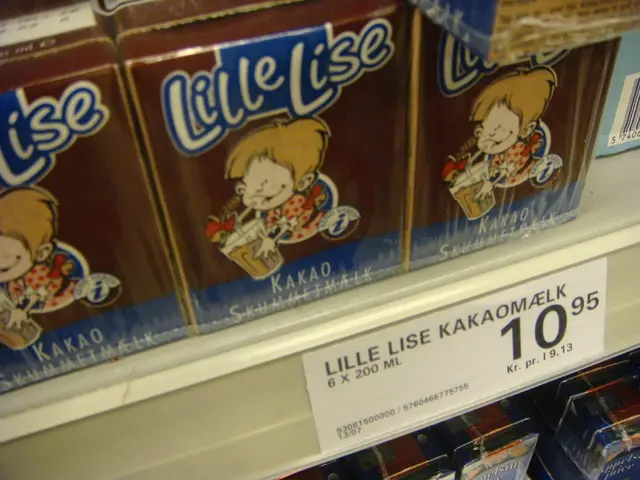Battle over Sausage Encasement: Are you beingdouble-charged for the wrapper again?
- by Matthias Urbach
- 3 Min
Controversy over Sausage Casing: Yet Another Excessive Packaging Cost? - Squabbling persists over the casing for the sausage.
The Federal Administrative Court in Leipzig recently weighed in on a heated dispute concerning liver sausage: Is the casing and metal clip part of the product or the wrapper? You pay for one, not the other. The controversy initially appeared resolved by an EU regulation from 1976: According to this, the casing and clips of sausages should belong to the product.
However, the weighing office responsible for the Warendorf district disagreed, citing a more recent food information regulation enacted in 2014. That rule prohibited the sale of liver sausage where the casing and clips were included in the total product weight. The outer wrapping claimed 130 grams of liver sausage, but in reality, it weighed less than 128 grams – due to the weight of the clip and casing.
This led to a lengthy legal battle. The Administrative Court sided with the weighing office, the Higher Administrative Court with the manufacturer. In a recent decision, the highest court in such matters, the Federal Administrative Court, ruled in favor of the weighing office. "The actual food inside should equal the stated weight on the outside," stated Judge Ulla Held-Daab in her final verdict. Non-edible casings and clips do not count.
The Wrapper Rule Dates Back to Trading Origins
Most consumers likely don't mind footing the bill for the sausage casing. Many may not even be aware of the rules in the food industry. It's been quiet about "the Tara" for decades. Tara is the trade term for "wrapper weight," specifically for weight deductions for packaging. Essentially, only the product needs to be paid for, not the wrapping.
The trend to only pay for the product may date back as far as trade itself. The word Tara comes from the Arabic "taraha," meaning "remove" – and was adopted into German via Italian in the 14th century.
Tara Fraud: An Old Issue Rears its Head Again
In the past, there were numerous complaints to consumer centers about the packaging being weighed during weekly markets, resulting in customers overpaying. Particularly for high-quality products like Parma ham or North Sea crabs, these extra charges could quickly amount to 50 cents and more.
With the advent of supermarkets, pre-packaged goods gained popularity. Manufacturers complied with the rules, and complaints dwindled. "Only the older ones were still interested in that," Armin Valet from the Consumer Center Hamburg told stern, "the younger ones not so much." Perhaps a little knowledge about the Tara rules has been lost.
However, the problem is resurfacing: Given the rising focus on sustainability, more and more customers are bringing their own wrapping. Supermarkets themselves are offering reusable nets for fruit and vegetables. With the various bags, bags, and nets at checkout, staff appear to be struggling. According to the Consumer Center Baden-Württemberg, 16 test purchases with reusable nets last year resulted in more than half of the test customers being overcharged.
A Cotton Bag for Fruit Weighs 56 grams
To make matters worse, new reusable bags are significantly heavier than plastic bags. A cotton net purchased from the consumer advocates in a store weighed a hefty 56 grams. If the usual two grams of wrapper weight for a plastic bag are deducted, this can result in a noticeable difference. With expensive organic fruit, consumers could easily overpay by a euro or more. Unfortunately, most stores do not display the wrapper weight on the receipts.
Despite this, the system appears to be malfunctioning. In two test purchases by the Verbraucherzentrale Baden-Württemberg, the markets undercharged. And if you use the self-checkout at Edeka and weigh items yourself, you're overwhelmed by the options: a Berlin branch offered 18 different tariff weights, ranging from 2 to 222 grams.

Retail: Untroubled by Packaging Regulations
The German Retail Association (BVLH) also maintains that there are no issues with the tariff rules: "We strictly adhere to metrology laws," says association lawyer Axel Haentjes. "If it's unclear whether a package weighs two grams or four grams, we'll subtract four grams."
So, what can consumers do? Be mindful to select the wrapper button during weighing at the checkout – it's usually indicated. If you can't locate the appropriate wrapper weight at the self-checkout, it's best to weigh without a bag. In the end, only the product should be paid for, not the wrapping.
And this rule now applies to liver sausage, as of yesterday.
Sources: Federal Administrative Court, Higher Administrative Court of North Rhine-Westphalia, BVLH, Verbraucherzentrale Hamburg, Verbraucherzentrale Baden-Württemberg, with dpa
- Wrapping
- Food
- Sausage
Enrichment Data:
Overall:
German regulations pertaining to sausage packaging focus primarily on packaging sustainability and recyclability rather than specifying specific legal limits or requirements on the weight of the sausage product or packaging.
Packaging Regulations:
- An upcoming European Packaging and Packaging Waste Regulation (PPWR) applies to Germany, requiring a defined proportion of recycled content in contact-sensitive packaging like meat and sausage packaging by 2030. The regulation also mandates that packaging be recyclable according to certain standards. This extends to packaging used in community catering (Horeca sector) including sausages[1][2][4].
- German packaging for sausages is transitioning towards sustainable, high-barrier films made with recycled polyamide materials (such as BASF’s Ultramid Ccycled) that meet minimum German recyclability standards in polyethylene film streams. This represents a push towards increased circularity and closed-loop recycling of food packaging[1][4].
- Efficient packaging solutions including clip closures for meat products are advocated for. These systems prioritize minimizing packaging material while ensuring product safety and compliance with environmental regulations like the EU PPWR[5].
Weight of Sausage Product and Packaging:
- The search results do not specify explicit regulatory limits or standards on the exact net weight of sausage products or the permissible weight of packaging.
- Standard EU weight-labeling laws require accurate product weight declaration on food packaging to prevent deception of consumers. This means the packaging must contain the weight indicated on the label, but the exact permitted packaging weight is generally not regulated separately; instead, packaging is regulated regarding safety, hygiene, and environmental standards.
- Consumers may unknowingly pay for the casing and clips of sausages, as the weight of these parts is included in the total product weight according to some regulations.
- The controversy over the sausage encasement was recently resolved by the Federal Administrative Court in Leipzig, which ruled that the actual food inside should equal the stated weight on the outside, not including non-edible casings and clips.
- The German Retail Association maintains that there are no issues with the tariff rules, suggesting that if there's uncertainty about the weight of a package, a heavier weight should be subtracted to account for the packaging.
- In light of the rising focus on sustainability, more customers are bringing their own wrapping, resulting in confusion for store staff and potential overcharging.
- Given the complexities in packaging regulations and weight declarations, consumers are advised to be mindful during checkout and, if possible, weigh their items without a bag to avoid paying for the wrapping.









